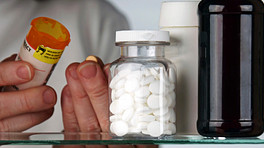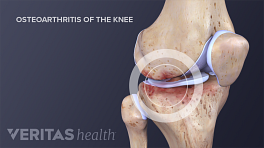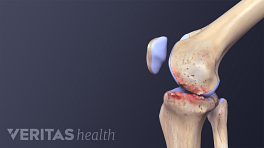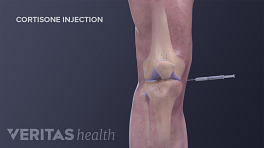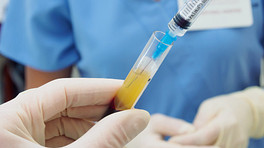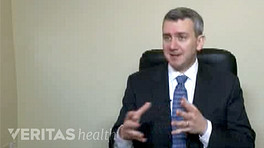Platelet-rich plasma therapy, sometimes called PRP therapy or autologous conditioned plasma (ACP) therapy, attempts to take advantage of the blood's natural healing properties to repair damaged cartilage, tendons, ligaments, muscles, or even bone.
Although not considered standard practice, a growing number of people are turning to PRP injections to treat an expanding list of orthopedic conditions, including osteoarthritis. It is most commonly used for knee osteoarthritis, but may be used on other joints as well.
In This Article:
- Platelet-Rich Plasma (PRP) Therapy for Arthritis
- PRP Injection Preparation and Composition
- Efficacy of Platelet-Rich Plasma Injections
- Potential Pros and Cons of PRP Injections
- Choosing a PRP Therapy Doctor
- Who Is a Candidate for Platelet-Rich Plasma Therapy?
- Platelet-Rich Plasma Injection Procedure
This article describes how experts think PRP works, who might consider PRP injections for osteoarthritis, how to choose a doctor, and the injection procedure. Also discussed is the available research examining whether PRP is an effective treatment for osteoarthritis.
When treating osteoarthritis with platelet-rich plasma, a doctor injects PRP directly into the affected joint. The goal is to:
- Reduce pain
- Improve joint function
- Possibly slow, halt, or even repair damage to cartilage
Platelet-rich plasma is derived from a sample of the patient's own blood. The therapeutic injections contain plasma with a higher concentration of platelets than is found in normal blood.
What is plasma? Plasma refers to the liquid component of blood; it is the medium for red and white blood cells and other material traveling in the blood stream. Plasma is mostly water but also includes proteins, nutrients, glucose, and antibodies, among other components.
What are platelets? Like red and white blood cells, platelets are a normal component of blood. Platelets alone do not have any restorative or healing properties; rather, they secrete substances called growth factors and other proteins that regulate cell division, stimulate tissue regeneration, and promote healing. Platelets also help the blood to clot; a person with defective platelets or too few platelets will bleed excessively from a cut.
There is no universally accepted medical definition for “platelet-rich plasma,” so a PRP injection that one patient receives can be very different than that of another. Variations occur for many reasons, including:
- Patient characteristics. Blood composition (e.g. number of platelets) can differ from patient to patient.
- Processing of blood. How a patient's blood sample is processed (e.g. centrifuged and filtered) affects the concentrations of platelets and white blood cells in a PRP injection.
- Additives. Doctors may augment platelet-rich plasma with substances that are thought to enhance the PRP's healing properties.
How PRP production and composition affects the therapy's effectiveness is not well understood. Until more research is done, patients considering platelet-rich plasma therapy should take time to learn what is known about PRP.
What Does Platelet-Rich Plasma Therapy Do?
Experts are unsure exactly how PRP therapy may alleviate symptoms for certain orthopedic conditions. Doctors who use PRP therapy to treat osteoarthritis theorize that the platelet-rich plasma might:
- Inhibit inflammation and slow down the progression of osteoarthritis 1 Van Buul GM, Koevoet WLM, Kops N, et al. Platelet-rich plasma relea- sate inhibits inflammatory processes in osteoarthritic chondrocytes. Am J Sports Med. 2011;39:2362–2370.
- Stimulate the formation of new cartilage 2 Drengk A, Zapf A, Sturmer EK, et al. Influence of platelet-rich plasma on chondrogenic differentiation and proliferation of chondrocytes and mes- enchymal stem cells. Cells Tissues Organs. 2009;189:317–326.
- Increase the production of natural lubricating fluid in the joint, thereby easing painful joint friction 3 Anitua E, Sanchez M, Nurden AT, et al. Platelet-released growth factors enhance the secretion of hyaluronic acid and induce hepatocyte growth factor production by synovial fibroblasts from arthritic patients. Rheuma- tology (Oxford). 2007;46:1769–1772.
- Contain proteins that alter a patient's pain receptors and reduce pain sensation 4 Descalzi F, Ulivi V, Cancedda R, Piscitelli F, Luongo L, Guida F, Gatta L, Maione S, Di Marzo V. Platelet-rich plasma exerts antinociceptive activity by a peripheral endocannabinoid-related mechanism. Tissue Eng Part A. 2013 Oct;19(19-20):2120-9. doi: 10.1089/ten.TEA.2012.0557. Epub 2013 Jun 6. PubMed PMID: 23578218. , 5 The International Cellular Medical Society. Guidelines for the Use of Platelet Rich Plasma. Adopted 2011. www.cellmedicinesociety.org. Accessed August 15, 2013.
It could be that platelet-rich plasma does all of these things, or none. 5 The International Cellular Medical Society. Guidelines for the Use of Platelet Rich Plasma. Adopted 2011. www.cellmedicinesociety.org. Accessed August 15, 2013. More large-scale, high-quality clinical studies are needed before scientists can know.
- 1 Van Buul GM, Koevoet WLM, Kops N, et al. Platelet-rich plasma relea- sate inhibits inflammatory processes in osteoarthritic chondrocytes. Am J Sports Med. 2011;39:2362–2370.
- 2 Drengk A, Zapf A, Sturmer EK, et al. Influence of platelet-rich plasma on chondrogenic differentiation and proliferation of chondrocytes and mes- enchymal stem cells. Cells Tissues Organs. 2009;189:317–326.
- 3 Anitua E, Sanchez M, Nurden AT, et al. Platelet-released growth factors enhance the secretion of hyaluronic acid and induce hepatocyte growth factor production by synovial fibroblasts from arthritic patients. Rheuma- tology (Oxford). 2007;46:1769–1772.
- 4 Descalzi F, Ulivi V, Cancedda R, Piscitelli F, Luongo L, Guida F, Gatta L, Maione S, Di Marzo V. Platelet-rich plasma exerts antinociceptive activity by a peripheral endocannabinoid-related mechanism. Tissue Eng Part A. 2013 Oct;19(19-20):2120-9. doi: 10.1089/ten.TEA.2012.0557. Epub 2013 Jun 6. PubMed PMID: 23578218.
- 5 The International Cellular Medical Society. Guidelines for the Use of Platelet Rich Plasma. Adopted 2011. www.cellmedicinesociety.org. Accessed August 15, 2013.


